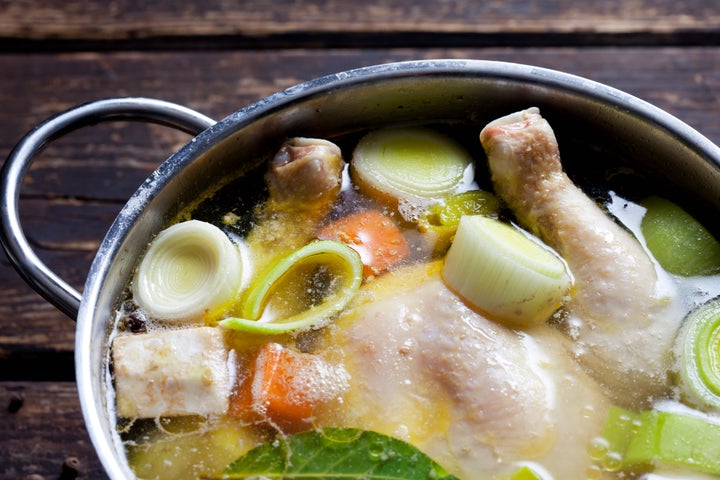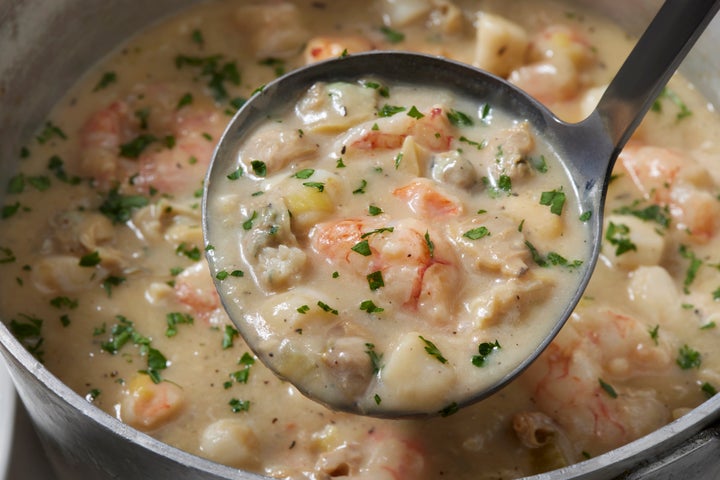
While reading a soup recipe or watching a chef make a batch of chicken noodle on TikTok, you may have noticed an instruction urging you to use a spoon or a mesh strainer to “skim” foam from the top of the soup pot.
But what’s the point of skimming? Is the “scum” that floats atop simmering soup really that bad? And do all types of soup need to be skimmed, or is it OK to leave out that step sometimes?
We spoke to professional chefs, culinary educators and food scientists to get answers to these questions, just in time for peak soup season.
Why is skimming recommended?
“Scum, in reference to soup skimming, is mostly the coagulation of protein particles held together with fat,” explained McKenzie Johnson, a chef-instructor at the Auguste Escoffier School of Culinary Arts who teaches a class called Foundations of Soup-Making. “Some of this protein clumps up more depending on your ingredients, causing small chunks to rise, but most of it remains a conglomerate of film and even foam that rises to the top at the simmering process.”
Skimming these particles off the top is mainly “for cosmetic purposes,” explained Bryan Quoc Le, a food scientist. The scum “just doesn’t look great in a soup,” Le said.
In addition to the visual impact, Johnson told us that “it’s important to skim the scum early in the simmering process if you don’t want to have any unwanted mouth feel or flavor affecting your outcome. If you don’t skim the scum before it rapidly boils, it can drop back into the soup.”
Is the scum that floats to the top of the soup safe to eat?
While the scum can cloud a broth and generally look unappetizing, food scientist Brian Chau of Chau Time assured us that these fats and proteins won’t pose any threat to health.
“Skimming the scum is not a food safety issue. If there is some scum left over, the soup is still consumable,” Chau said. “Flavor is subjective to each person, and some people may like the proteins floating on top. People can try a soup with and without the scum and make the call. Home cooks can save time by not skimming.”

Do all types of soup need to be skimmed?
As Chau explained, soup skimming is never actually necessary. Don’t want to skim? That’s fine! But all of our experts acknowledged there’s one type of soup that tends to reap more advantages from skimming: broth-based soups like pho, vegetable soup and even chicken noodle soup.
“Skimming is most important in the case of clear broths or soups, since the scum can make the soup look cloudy,” said Jessica Botta, a chef-instructor at the Institute of Culinary Education.
If you’re worried that skimming the fat and proteins from a brothy soup will compromise its flavor, Johnson has a helpful suggestion: Clear the scum from the top “and then control the fat shape and flavors” by adding a drizzle of olive oil or even a pat of cold butter.
When it comes to thicker and more substantial soups, skimming has less of an effect on the aesthetics, but it can still be a worthwhile step. Anthony Sitek, the chef and owner of Crown Restaurant Group in Cincinnati, Ohio, told us that skimming a soup “like beef bourguignon or even French onion will give you a slightly less greasy mouthfeel.”
Even cream-based soups may benefit from a quick skim. “I made a batch of clam chowder every day for a couple of years while working in a restaurant,” Johnson said. “I’ll say one thing for sure: While I wasn’t too worried about skimming scum, I was concerned about the thick film that can form on top [of a creamy soup] as it cools. The film can become dense particles that get pushed into the soup and form concentrated flavors and unwanted textures. This can happen with any cream-based soup, so you want to keep a close eye on it, and if the film is too thick, consider skimming it off completely rather than trying to mix it in.”